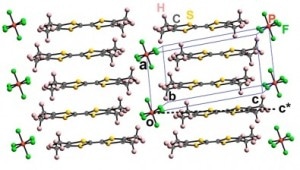Apr 12 2018
The phenomenon of superconductivity, which was discovered by chance more than a century earlier, has continually promoted a technological revolution. In 1911, while analyzing the properties of solid mercury supercooled to 4 K, or −269 °C, Heike Kamerlingh Onnes (1853–1926), a Dutch physicist, noticed for the first time that specific materials had the ability to conduct electricity without resistance or losses at temperatures close to absolute zero.
 The exotic behaviors displayed by organic compounds subjected to low temperatures are explored in a paper published in Physical Review B. (Image credit: UNESP)
The exotic behaviors displayed by organic compounds subjected to low temperatures are explored in a paper published in Physical Review B. (Image credit: UNESP)
Researchers again showed interest in the 1980s when they experimentally observed superconductivity at considerably higher temperatures in the range of 90 K, or −183 °C. Later, this level was outweighed, and the anticipation of observing superconductivity at ambient temperature at present inspires studies at various front-ranking scientific institutions.
This information has offered the framework for a research recently carried out by the Solid State Physics Group at São Paulo State University (UNESP) in Rio Claro, Brazil. Valdeci Pereira Mariano de Souza was the principal investigator of this research. Apart from other researchers affiliated to UNESP, the group included researchers from Paris South University (Orsay) in France. The outcomes were acquired in Rio Claro with the help of equipment bought with FAPESP’s support.
An article related to the study was published in the Physical Review B journal. The entire text can be downloaded from arxiv.org/pdf/1801.00626.pdf.
“In several materials, the superconductive phase is manifested in the proximity of what’s known as the ‘Mott insulating phase’. The Mott metal-insulator transition is a sudden change in electrical conductivity that occurs at a given temperature when the Coulomb repulsion between electrons becomes comparable to the free-electron kinetic energy,” Mariano told Agência FAPESP.
“When the Coulomb repulsion becomes relevant, the electrons that were itinerant become localized, and this minimizes the system’s total energy. This electron localization is the Mott insulating phase. In some cases, an even more exotic process unfolds. Because of the interactions between electrons occupying neighboring sites in the network, the electrons rearrange themselves in the network in a non-homogeneous manner, and a so-called ‘charge ordering phase’ occurs. Our study addressed this kind of phenomenon.”
During the charge ordering phase, the non-homogeneous charge distribution, which is at times accompanied by a distortion in the crystalline network, renders the material electrically polarized, and consequently, it acts like a ferroelectric material. This stage was named as the “ferroelectric Mott-Hubbard phase” after Nevill Mott (1905–1996), 1977 Nobel Laureate in Physics, and John Hubbard (1931–1980), two British physicists who conducted research on the subject.
For the experimental investigation of these exotic phases, the UNESP scientists selected a material known as Fabre salts, which are formed from tetramethyltetrathiafulvalene (TMTTF), an organic molecule with a symmetrical configuration including a central double carbon bond and two methyl radicals on both sides. To achieve the coldest and most magnetic point available at UNESP, with a temperature of 1.4 K and a field of 12 Tesla, they used a cryostat, which was also purchased with FAPESP’s support.
With this experimental setup, we aimed not just to characterize materials, although that’s important, but to investigate the fundamental properties of matter that manifest themselves under extreme conditions. Fabre salts have extremely rich phase diagrams for those who undertake this kind of research. The molecular systems concerned had already been explored using nuclear magnetic resonance imaging, infrared spectroscopy and other techniques. What we essentially did was measure their dielectric constants in the low-frequency regime.
Valdeci Pereira Mariano de Souza
It is important to remember that the dielectric constant differs for different materials and, although it is a macroscopic quantity, it shows the polarizability of a material.
“Given that Fabre salts are highly anisotropic and therefore have strongly crystallographic-direction-dependent transport properties, when charge ordering occurs, we observe Mott-Hubbard electric polarization throughout the TMTTF stack. This polarization is considerable and was reported in the literature in 2001,” stated Mariano.
“The ionic contribution to the dielectric constant of these materials was measured for the first time in this study. We found that as the temperature decreases, the ionic contribution also decreases, which gives rise to the Mott-Hubbard phase. This was a new observation that had not yet been reported in the literature—a genuinely original contribution of ours. We also explored the effect of the disorder induced by irradiation in the Mott-Hubbard phase in detail.”
He added that this is significant due to the proximity of the Mott-Hubbard ferroelectric phase to superconductivity.
William Little, Emeritus Professor of Physics at Stanford University, stated that low-dimensional molecular conductors would be candidates for obtaining room temperature superconductivity. In his work, Little proposed that room temperature superconductivity would be achieved by means of ‘spines’, or conducting chains with highly polarizable side chains. The materials we’re studying have precisely these elements.
Valdeci Pereira Mariano de Souza
The first step was the production of spines. The subsequent step, which has been already devised by the scientists in Rio Claro, is to stress Fabre salts to produce superconductivity in the Mott-Hubbard ferroelectric phase.